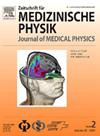0.55T: bSTAR超高分辨率脑MRI及其在磁化转移比成像中的应用。
IF 4.2
4区 医学
Q2 RADIOLOGY, NUCLEAR MEDICINE & MEDICAL IMAGING
引用次数: 0
摘要
目的:本研究旨在评估在0.55 T下使用三维半径向双回波平衡稳态自由进动序列(bSTAR)进行结构亚毫米各向同性脑MRI的可行性,并评估其在高分辨率磁化转移成像方面的潜力。方法:幻影和体内成像的三个健康的志愿者进行低场0.55 T mr系统各向同性bSTAR分辨率设置为0.87 × 0.87×0.87 mm3和0.69×0.69 ×0.69 mm3。此外,使用三维双回波破坏梯度成像进行非共振成像。对于磁化转移(MT) MRI,修改了0.87 mm bSTAR扫描的RF脉冲持续时间。数据重构采用gpu加速压缩感知算法。磁化传递比(MTR)图由两次bSTAR扫描计算,有和没有RF脉冲延长。MTR扫描耗时5分钟,通过重复扫描评估再现性。结果:非共振成像显示,即使在鼻腔附近,当TR < 5ms时,bSSFP脑成像基本上没有与非共振相关的伪影。幻影和活体扫描证明了亚毫米各向同性bSTAR成像的可行性。用高各向同性分辨率bSTAR获得的MTR地图显示了白质和灰质之间的对比,与高场研究的预期一致。MTR测量具有高重复性,平均扫描间MTR峰值为43.3 ± 0.3%单位。结论:本研究证明了在0.55 T时使用bSTAR进行亚毫米和无伪影的脑形态成像的潜力,利用低场MRI的优势,如减少敏感性伪影和改善射频场均匀性。此外,mt致敏的bSTAR脑MRI能够在临床可行的时间内进行全脑MTR评估,并且具有高重复性。本文章由计算机程序翻译,如有差异,请以英文原文为准。
Ultra-high-resolution brain MRI at 0.55T: bSTAR and its application to magnetization transfer ratio imaging
Purpose
This study aims to evaluate the feasibility of structural sub-millimeter isotropic brain MRI at 0.55 T using a 3D half-radial dual-echo balanced steady-state free precession sequence, termed bSTAR and to assess its potential for high-resolution magnetization transfer imaging.
Methods
Phantom and in-vivo imaging of three healthy volunteers was performed on a low-field 0.55 T MR-system with isotropic bSTAR resolution settings of 0.87 × 0.87 × 0.87 mm3 and 0.69 × 0.69 × 0.69 mm3. Furthermore, off-resonance mapping was performed using 3D double-echo spoiled gradient imaging. For magnetization transfer (MT) MRI, the RF pulse duration of the 0.87 mm bSTAR scan was modified. Data were reconstructed using a GPU-accelerated compressed sensing algorithm. Magnetization transfer ratio (MTR) maps were calculated from two bSTAR scans with and without RF pulse prolongation. The MTR scan took 5 minutes and the reproducibility was assessed through repeated scans.
Results
Off-resonance mapping revealed that bSSFP brain imaging with TR < 5ms is essentially free of off-resonance-related artifacts even near the nasal cavities. Phantom and in-vivo scans demonstrated the feasibility of sub-millimeter isotropic bSTAR imaging. MTR maps obtained with high isotropic resolution bSTAR showed contrast between white and gray matter in agreement with expectations from high-field studies. The MTR measurements were highly reproducible with an average inter-scan MTR peak value of 43.3 ± 0.3 percent units.
Conclusions
This study demonstrated the potential of sub-millimeter and artifact-free morphologic brain imaging at 0.55 T using bSTAR leveraging the advantages of low-field MRI, such as reduced susceptibility artifacts and improved radio-frequency field homogeneity. Furthermore, MT-sensitized bSTAR brain MRI enabled whole-brain MTR assessment within clinically feasible times and with high reproducibility.
求助全文
通过发布文献求助,成功后即可免费获取论文全文。
去求助
来源期刊
CiteScore
3.70
自引率
10.00%
发文量
69
审稿时长
65 days
期刊介绍:
Zeitschrift fur Medizinische Physik (Journal of Medical Physics) is an official organ of the German and Austrian Society of Medical Physic and the Swiss Society of Radiobiology and Medical Physics.The Journal is a platform for basic research and practical applications of physical procedures in medical diagnostics and therapy. The articles are reviewed following international standards of peer reviewing.
Focuses of the articles are:
-Biophysical methods in radiation therapy and nuclear medicine
-Dosimetry and radiation protection
-Radiological diagnostics and quality assurance
-Modern imaging techniques, such as computed tomography, magnetic resonance imaging, positron emission tomography
-Ultrasonography diagnostics, application of laser and UV rays
-Electronic processing of biosignals
-Artificial intelligence and machine learning in medical physics
In the Journal, the latest scientific insights find their expression in the form of original articles, reviews, technical communications, and information for the clinical practice.

 求助内容:
求助内容: 应助结果提醒方式:
应助结果提醒方式:


